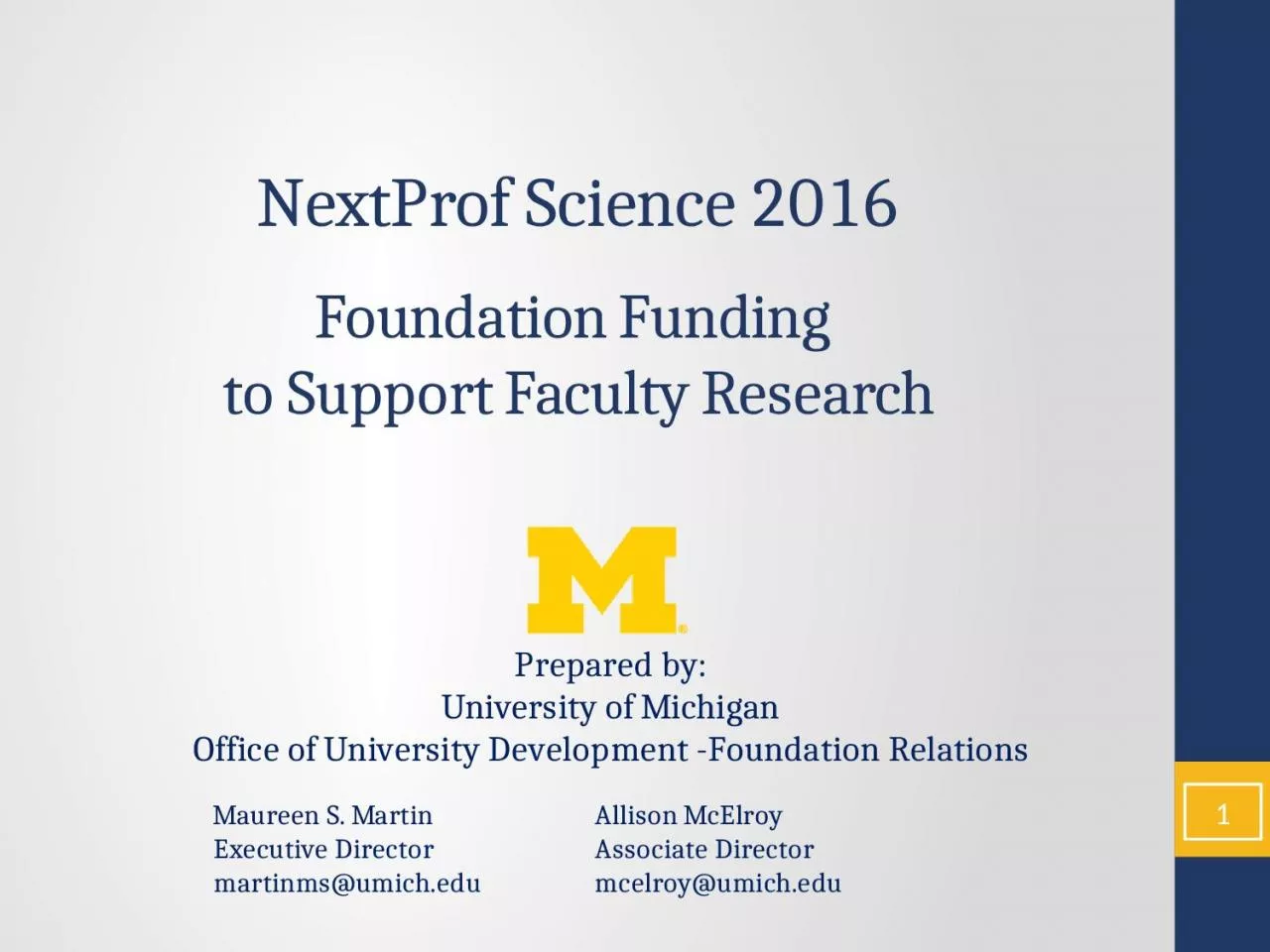

to Support Faculty Research 1 Prepared by University of Michigan Office of University Development Foundation Relations Maureen S Martin Allison McElroy Executive Director Associate Director ID: 1032828
Download Presentation The PPT/PDF document "NextProf Science 2016 Foundation Funding" is the property of its rightful owner. Permission is granted to download and print the materials on this web site for personal, non-commercial use only, and to display it on your personal computer provided you do not modify the materials and that you retain all copyright notices contained in the materials. By downloading content from our website, you accept the terms of this agreement.
1. NextProf Science 2016Foundation Funding to Support Faculty Research1Prepared by:University of MichiganOffice of University Development -Foundation RelationsMaureen S. Martin Allison McElroyExecutive Director Associate Directormartinms@umich.edu mcelroy@umich.edu
2. Overview2Foundation basicsWhat do they fund?Top science fundersEngaging with foundations
3. The Basics: What is a foundation?3A private charity established to make grants that meet a mission created in its charteringThere are 87,142 foundations in the U.S. (as of 2013)Foundations granted more than $55 billion in 2013The top 25 foundations (.03%) gave 23.5% of all funding nationally
4. Who leads?4Bill & Melinda Gates Foundation – Seattle, WA Assets: $41 Billion, Annual giving: $3.3 BillionWellcome Trust* – London, England Assets: $26 Billion, Annual giving: $1.2 Billion * historically funded only within UK; starting to make grants in the USFord Foundation – New York, NY Assets: $12.2 Billion, Annual giving: $560 MillionRobert Wood Johnson Foundation – Princeton, NJ Assets: $10.1 Billion, Annual giving: $337 MillionW.K. Kellogg Foundation – Battle Creek, MI Assets: $8.6 Billion, Annual giving: $294 MillionWilliam & Flora Hewlett Foundation – Menlo Park, CA Assets: $8.6 Billion, Annual giving: $240 Million
5. Types of Foundationsand how universities engage with themCommunityOperatingCorporate5Industry support; usually managed by Corporate Relations staffBehave like Individual Donors; usually managed by Major Gift OfficersUsually managed by Foundation Relations staff
6. What do Foundations Fund?6
7. Foundations are niche science funders7 What They Like What They Don’t LikeTheir own goalsInnovation and riskEvidence of young investigator promiseBold, active languageCreative or leading edge scienceApplied researchEstablishing or operating “centers”Student support*Market-driven solutionsPublishing as the outcome*Other than students engaged in the work While these are massive generalizations, they hold with most foundations.
8. Funding to Top Public Universities8
9. What Foundation Funding Offers9Support for junior faculty in launching their careersPrestige – junior and senior faculty awards: Keck, Sloan, PackardSupport “out-of-the-box” ideas and high-risk, high-return projectsPilot or proof-of-concept funding Focus attention on a particular problem or disease (Cancer Society)
10. How are foundations different?10Some are not peer-reviewedBut program officers can be highly knowledgeable about program areasExceptions can include foundations that fund researchStrong focus on outcomes and impacts in their focus areasDoes this help solve a problem of interest to the foundation? How does it contribute? What will be different?Focus on risky scienceDoes the investigator show passion and promise?Does their research stand out from the crowd; have new approaches?Often a focus on underserved populationsGates: “all people have the chance to live a healthy and productive life.”Kresge: “expand opportunities for low-income people”One-Time Funding – Pilot or launch (1-3 years), not sustainable funding.
11. Why Foundations Support Science11Push the envelope of science; bridge innovative ideas into NIH and NSF; want to be where no one else is.Some think federal funding system of review is broken or isn’t paying enough attention to their area(s) of interest.Think private philanthropy can have quicker impact on the world’s problems (Gates)Focus attention on a particular problem or disease (Cancer Society)
12. Associations as funders12Organized based on a specific affinity: disease, field of study, professionAmerican Heart AssociationMarch of Dimes Birth Defect FoundationBrain and Behavior Research FoundationHuman Frontier Science ProgramSociety for Developmental BiologyFocus is on researchMost funding proposals are peer-reviewed
13. Top Science Funders13
14. 14Early Career Funding Opportunities Alfred P. Sloan Foundation – Sloan Research FellowsBeckman Foundation – Young Investigator; Beckman Postdoc FellowsBrain and Behavior Research Foundation – Young Investigator GrantBurroughs Wellcome Fund – Career Awards: Scientific InterfaceDamon Runyon Cancer Research Foundation – Damon Runyon FellowshipsDavid and Lucile Packard Foundation – Packard FellowshipsHoward Hughes Medical Institute – Early Career ScientistHuman Frontier Science Program – Young Investigator Research GrantsPaul G. Allen Foundation – Distinguished Investigators Simons Foundation – Origins of Life Postdoc Fellowships
15. Other Prestigious Awards:15Gates Foundation – Grand Challenges ExplorationHartwell Foundation – Biomedical Research AwardsKeck Foundation – Medical, Science & Engineering Research AwardsSidney Kimmel – Kimmel Scholars Program (biomed & cancer)Moore Foundation – Advancing basic scienceOther top funders:American Cancer SocietyAmerican Chemical SocietyAmerican Heart AssociationMarch of Dimes FoundationPardee Foundation, Elsa U.Whitehall Foundation
16. Universities have staff members who are experienced with the process of engaging with professional foundations. These staff – Foundation Relations or Corporate & Foundation Relations - can assist with:1:1 advisory meetings with faculty membersTargeted prospecting of potential fundersStrategic analysis of past and likely performance in prestigious competitionsConnecting faculty with foundation program officers Facilitating proposal development and submission processArticulate proposal content in terms of foundation language. (i.e. write for an educated lay audience with clearly articulated outcomes).NOTE: some awards may be limited submission opportunities that need to be coordinated by Foundation Relations staff members.Engaging with Foundations16
17. At your home institution:Office of Research – May provide information on submission processes, including limited submissions, as well as additional son-campus resourcesLibrary Services – May provide resources, strategies, and information on grant-seeking, including finding funders, proposal writing, university processes, and access to subscription-based online resources.Online:The Foundation Center: A comprehensive information source for U.S.-based foundations. searchable archives, Foundation Finder, Philanthropy Search Engine for the web (Sector Search), a virtual classroom with online tutorials for proposal writing, budgeting and more.Foundation Directory Online: This tool is best used for prospecting the grantmakers most likely to fund your project(s). It includes grantmaker information and funding history -- NOT specific funding opportunities.Additional Resources17
18. For additional information:18Maureen MartinExecutive DirectorFoundation Relations & Program InitiativesUniversity of Michiganmartinms@umich.eduAllison McElroyAssociate DirectorFoundation RelationsUniversity of Michiganmcelroya@umich.edu